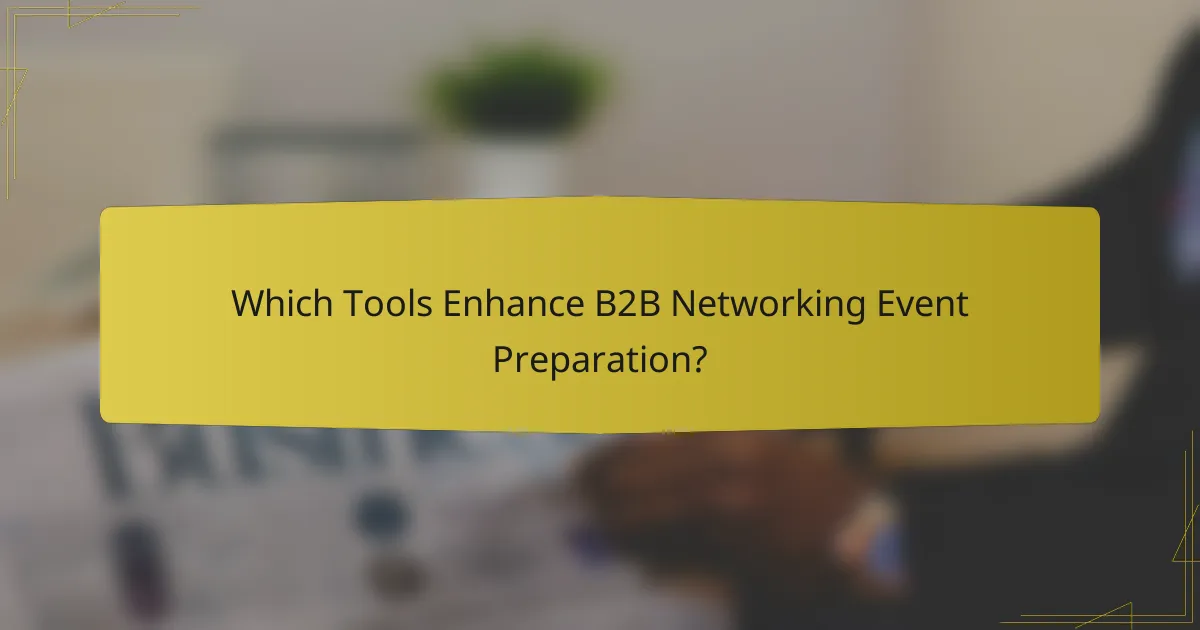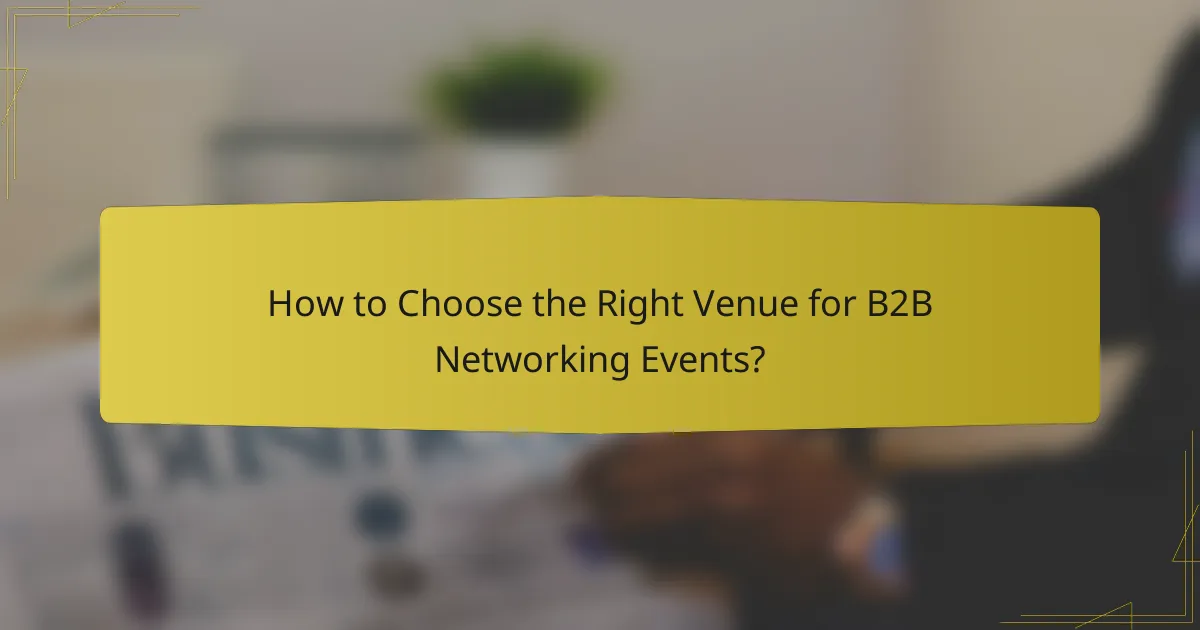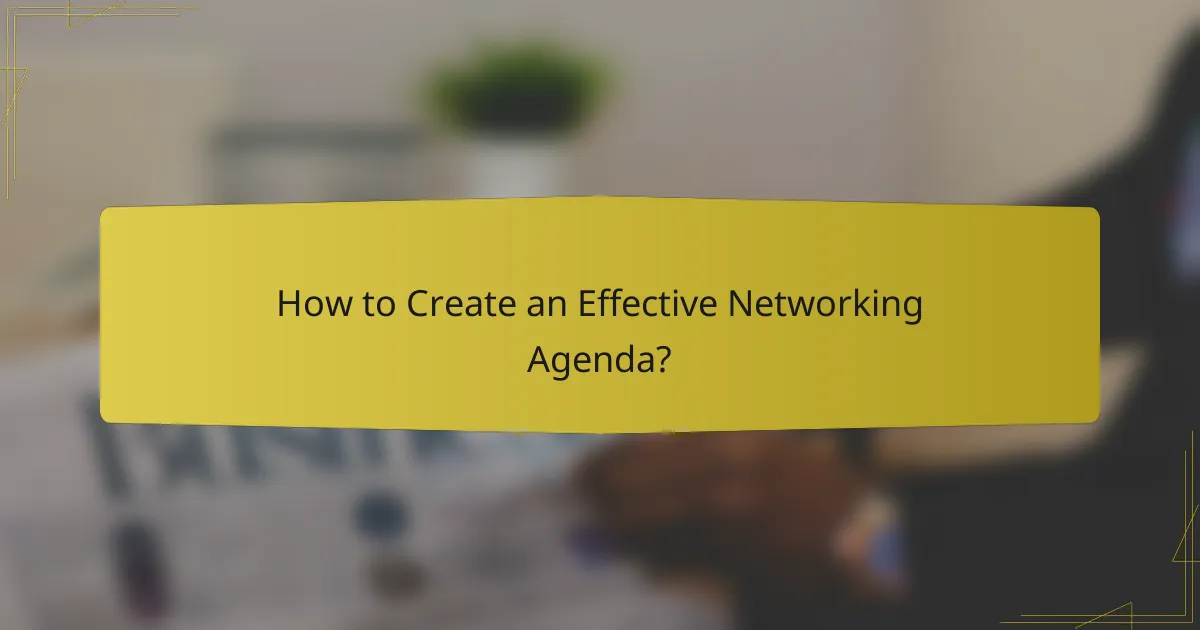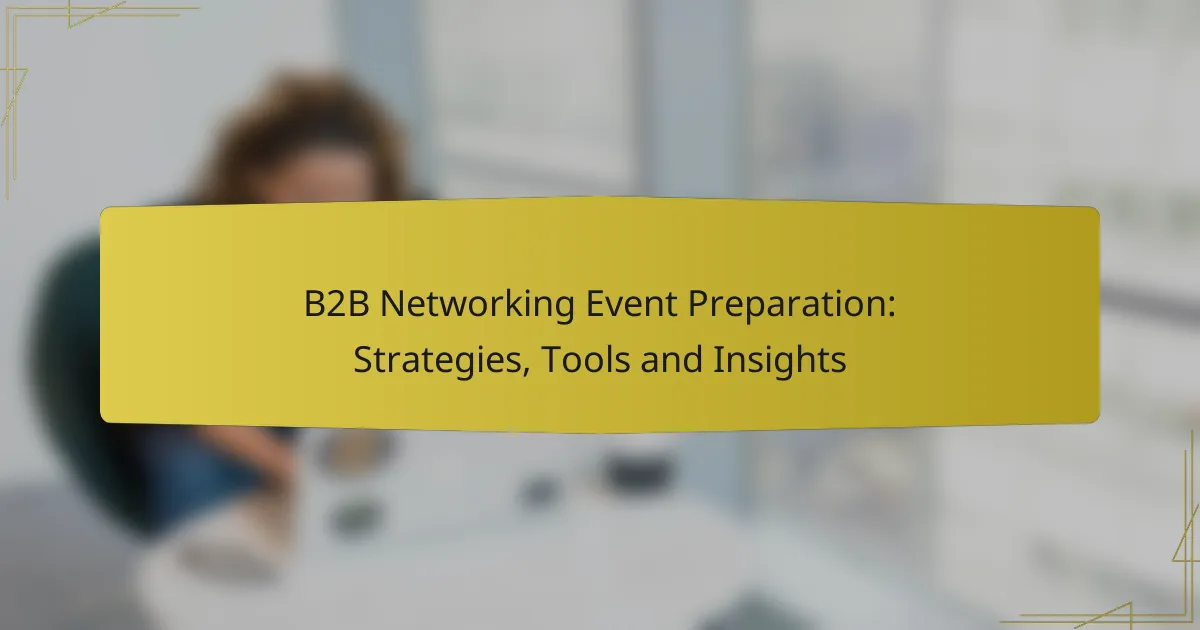Preparing for a B2B networking event involves a strategic approach that emphasizes careful planning, active participation, and effective follow-up. By leveraging the right tools and selecting an appropriate venue, you can enhance communication and create an inviting atmosphere that fosters meaningful connections. These strategies are essential for maximizing the potential of your networking opportunities and driving future business partnerships.

What Are Effective Strategies for B2B Networking Events?
Effective strategies for B2B networking events focus on thorough planning, active engagement during the event, and strategic follow-ups. These elements help build meaningful connections that can lead to business opportunities and partnerships.
Pre-event planning
Pre-event planning is crucial for maximizing the impact of a B2B networking event. Start by defining clear objectives, such as the types of connections you want to make or specific industries to target. Create a detailed agenda that includes time for networking, presentations, and discussions.
Consider logistics such as venue selection, catering, and technology needs. A well-organized event can enhance attendee experience and encourage participation. Make sure to send out invitations well in advance to ensure a good turnout.
Engagement tactics
Engagement tactics during the event can significantly influence the quality of interactions. Use icebreakers or structured networking sessions to facilitate introductions among attendees. Encourage participants to share their experiences and insights, fostering a collaborative environment.
Incorporating interactive elements, such as Q&A sessions or live polls, can keep attendees engaged and encourage dialogue. Ensure that your team is approachable and ready to assist attendees in making connections.
Follow-up strategies
Follow-up strategies are essential for converting initial meetings into lasting relationships. Send personalized thank-you emails within a few days of the event, referencing specific conversations to remind attendees of your interaction. This personal touch can help solidify connections.
Consider scheduling follow-up meetings or calls to explore potential collaborations. Utilize a CRM tool to track interactions and set reminders for future outreach, ensuring that no valuable connection is overlooked.
Utilizing social media
Utilizing social media can amplify your networking efforts before, during, and after the event. Create an event hashtag to encourage attendees to share their experiences and connect online. Promote the event on platforms like LinkedIn and Twitter to attract a wider audience.
After the event, share highlights, photos, and key takeaways on social media to maintain engagement and keep the conversation going. Tagging attendees can also encourage them to share your posts, expanding your reach.
Leveraging partnerships
Leveraging partnerships can enhance the effectiveness of your networking event. Collaborate with industry associations or complementary businesses to co-host the event, which can increase credibility and attract a larger audience. Shared resources can also reduce costs.
Consider inviting guest speakers from partner organizations to provide valuable insights and draw in their networks. This approach not only enriches the event content but also fosters a sense of community among attendees.

Which Tools Enhance B2B Networking Event Preparation?
Effective B2B networking event preparation relies on various tools that streamline organization, enhance communication, and facilitate connections. Utilizing the right software can significantly improve the efficiency and success of your event.
Event management software
Event management software is essential for planning and executing B2B networking events. These tools help with scheduling, registration, ticketing, and attendee management, ensuring a smooth experience for both organizers and participants.
Popular options include platforms like Eventbrite and Cvent, which offer features such as customizable registration forms and real-time analytics. When selecting software, consider factors like user interface, integration capabilities, and customer support.
CRM systems
Customer Relationship Management (CRM) systems play a crucial role in managing relationships with attendees and partners. They help track interactions, follow up on leads, and maintain organized contact information, which is vital for post-event engagement.
Tools like Salesforce and HubSpot can be integrated with event management software to streamline data sharing. Ensure your CRM allows for easy segmentation of contacts to tailor your communication strategies effectively.
Networking apps
Networking apps facilitate connections among attendees before, during, and after the event. These platforms enable participants to share profiles, schedule meetings, and engage in discussions, enhancing the networking experience.
Examples include Whova and Brella, which provide features like matchmaking based on interests and goals. Encourage attendees to download and actively use these apps to maximize their networking opportunities.
Virtual event platforms
Virtual event platforms are essential for hosting online B2B networking events, especially in a digital-first world. They provide tools for live streaming, breakout sessions, and interactive features that engage participants remotely.
Platforms such as Zoom Events and Hopin offer comprehensive solutions for virtual networking. When choosing a platform, consider the user experience, technical support, and features that facilitate interaction, like chat rooms and Q&A sessions.

How to Choose the Right Venue for B2B Networking Events?
Choosing the right venue for B2B networking events is crucial for fostering connections and ensuring a productive atmosphere. Consider factors such as location, capacity, technology, and ambiance to create an effective environment for networking.
Location accessibility
Location accessibility is vital for attracting attendees. Select a venue that is easily reachable by public transport and has ample parking options. A central location can significantly increase attendance, as it reduces travel time and inconvenience for participants.
Evaluate the surrounding area for amenities such as hotels, restaurants, and attractions. This can enhance the overall experience for attendees, especially if they are traveling from out of town.
Capacity and layout
Capacity and layout directly impact the networking experience. Ensure the venue can comfortably accommodate your expected number of attendees, allowing for movement and interaction. A space that is too large can feel empty, while a cramped venue may hinder engagement.
Consider the layout as well; open spaces encourage mingling, while designated areas for discussions can facilitate deeper conversations. Flexible seating arrangements can also adapt to different networking formats, such as round tables or lounge areas.
Technology and facilities
Technology and facilities play a key role in the success of B2B networking events. Ensure the venue is equipped with reliable Wi-Fi, audio-visual equipment, and charging stations. These amenities are essential for presentations and keeping attendees connected.
Check if the venue offers support staff to assist with technical needs during the event. Having knowledgeable personnel on hand can prevent disruptions and allow you to focus on networking.
Ambiance and branding
Ambiance and branding contribute to the overall impression of your networking event. Choose a venue that aligns with your brand identity and creates a welcoming atmosphere. Lighting, decor, and furniture should reflect your brand’s values and enhance the networking experience.
Consider incorporating branding elements, such as banners or digital displays, to reinforce your message. A well-branded environment can leave a lasting impression on attendees and encourage future engagement.

What Are Key Metrics for Evaluating Networking Event Success?
Key metrics for evaluating networking event success include attendee engagement levels, lead generation statistics, and post-event feedback. These metrics provide insights into how effectively the event met its goals and how participants interacted with one another and the content presented.
Attendee engagement levels
Attendee engagement levels can be assessed through various means, such as participation in discussions, Q&A sessions, and networking activities. High engagement often indicates that the event content resonated with attendees and encouraged interaction.
To measure engagement, consider tracking metrics like session attendance rates, the number of questions asked, and participation in polls or surveys. Aiming for at least 70% of attendees actively participating in sessions can be a good benchmark.
Lead generation statistics
Lead generation statistics reflect the number of potential business opportunities created during the event. This can include the number of new contacts made, business cards exchanged, or follow-up meetings scheduled.
To evaluate lead generation, track the number of qualified leads against the total number of attendees. A conversion rate of around 10-20% is often considered successful in B2B networking contexts.
Post-event feedback
Post-event feedback is crucial for understanding attendee satisfaction and areas for improvement. Collecting feedback through surveys or interviews can provide valuable insights into what worked well and what did not.
Focus on key questions regarding overall satisfaction, relevance of content, and likelihood of attending future events. Aim for a response rate of at least 30% to ensure the feedback is representative of the attendee experience.

How to Create an Effective Networking Agenda?
Creating an effective networking agenda involves outlining key sessions and activities that facilitate meaningful connections among participants. A well-structured agenda not only maximizes engagement but also ensures that attendees leave with valuable contacts and insights.
Time allocation for sessions
Proper time allocation is crucial for maintaining participant interest and ensuring that each session is productive. Aim for sessions that last between 30 to 60 minutes, allowing enough time for discussion without losing focus. Consider the overall event duration and break down the agenda into manageable segments to keep energy levels high.
For example, if your event runs for four hours, you might schedule three sessions of 45 minutes each, interspersed with breaks. This structure helps maintain momentum while allowing for flexibility based on attendee engagement.
Incorporating breaks
Incorporating breaks into your networking agenda is essential for fostering informal interactions and preventing burnout. Schedule short breaks of about 10 to 15 minutes between sessions, as well as longer breaks for meals or refreshments. These intervals provide opportunities for attendees to mingle and discuss ideas in a relaxed setting.
Ensure that breaks are clearly marked in the agenda, and consider offering refreshments to encourage attendees to stay engaged and connected during these times. This approach can significantly enhance networking opportunities.
Structured networking opportunities
Structured networking opportunities can greatly enhance the effectiveness of your event by guiding interactions among participants. Consider incorporating activities such as speed networking, roundtable discussions, or themed breakout sessions to facilitate targeted conversations.
For instance, speed networking allows attendees to meet multiple contacts in a short period, typically lasting 5 to 7 minutes per interaction. This format encourages quick exchanges of ideas and can lead to deeper discussions later on. Make sure to provide clear instructions and objectives for each structured opportunity to maximize participant engagement.
